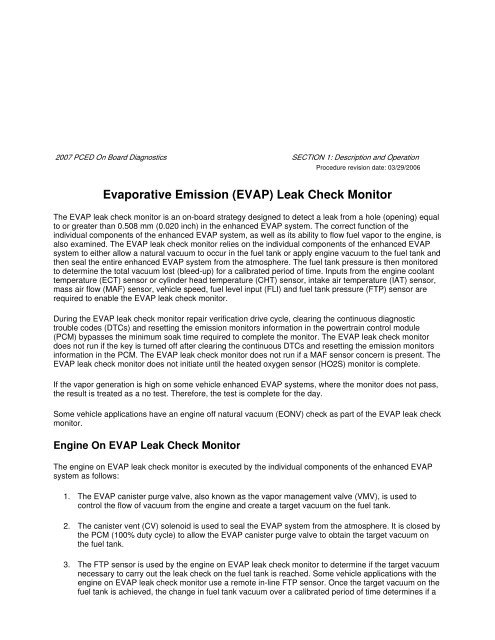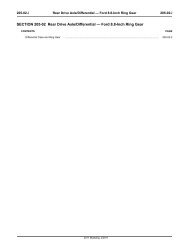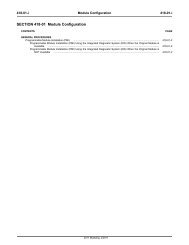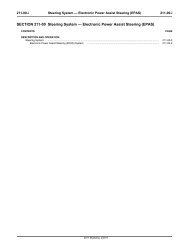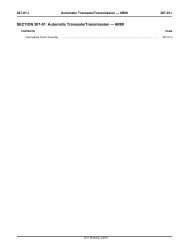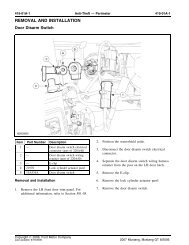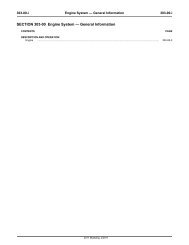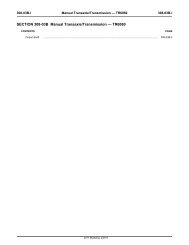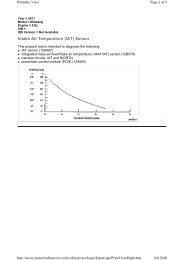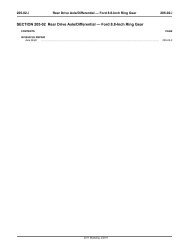Evaporative Emission (EVAP) Leak Check Monitor
Evaporative Emission (EVAP) Leak Check Monitor
Evaporative Emission (EVAP) Leak Check Monitor
Create successful ePaper yourself
Turn your PDF publications into a flip-book with our unique Google optimized e-Paper software.
2007 PCED On Board Diagnostics SECTION 1: Description and Operation<br />
Procedure revision date: 03/29/2006<br />
<strong>Evaporative</strong> <strong>Emission</strong> (<strong>EVAP</strong>) <strong>Leak</strong> <strong>Check</strong> <strong>Monitor</strong><br />
The <strong>EVAP</strong> leak check monitor is an on-board strategy designed to detect a leak from a hole (opening) equal<br />
to or greater than 0.508 mm (0.020 inch) in the enhanced <strong>EVAP</strong> system. The correct function of the<br />
individual components of the enhanced <strong>EVAP</strong> system, as well as its ability to flow fuel vapor to the engine, is<br />
also examined. The <strong>EVAP</strong> leak check monitor relies on the individual components of the enhanced <strong>EVAP</strong><br />
system to either allow a natural vacuum to occur in the fuel tank or apply engine vacuum to the fuel tank and<br />
then seal the entire enhanced <strong>EVAP</strong> system from the atmosphere. The fuel tank pressure is then monitored<br />
to determine the total vacuum lost (bleed-up) for a calibrated period of time. Inputs from the engine coolant<br />
temperature (ECT) sensor or cylinder head temperature (CHT) sensor, intake air temperature (IAT) sensor,<br />
mass air flow (MAF) sensor, vehicle speed, fuel level input (FLI) and fuel tank pressure (FTP) sensor are<br />
required to enable the <strong>EVAP</strong> leak check monitor.<br />
During the <strong>EVAP</strong> leak check monitor repair verification drive cycle, clearing the continuous diagnostic<br />
trouble codes (DTCs) and resetting the emission monitors information in the powertrain control module<br />
(PCM) bypasses the minimum soak time required to complete the monitor. The <strong>EVAP</strong> leak check monitor<br />
does not run if the key is turned off after clearing the continuous DTCs and resetting the emission monitors<br />
information in the PCM. The <strong>EVAP</strong> leak check monitor does not run if a MAF sensor concern is present. The<br />
<strong>EVAP</strong> leak check monitor does not initiate until the heated oxygen sensor (HO2S) monitor is complete.<br />
If the vapor generation is high on some vehicle enhanced <strong>EVAP</strong> systems, where the monitor does not pass,<br />
the result is treated as a no test. Therefore, the test is complete for the day.<br />
Some vehicle applications have an engine off natural vacuum (EONV) check as part of the <strong>EVAP</strong> leak check<br />
monitor.<br />
Engine On <strong>EVAP</strong> <strong>Leak</strong> <strong>Check</strong> <strong>Monitor</strong><br />
The engine on <strong>EVAP</strong> leak check monitor is executed by the individual components of the enhanced <strong>EVAP</strong><br />
system as follows:<br />
1. The <strong>EVAP</strong> canister purge valve, also known as the vapor management valve (VMV), is used to<br />
control the flow of vacuum from the engine and create a target vacuum on the fuel tank.<br />
2. The canister vent (CV) solenoid is used to seal the <strong>EVAP</strong> system from the atmosphere. It is closed by<br />
the PCM (100% duty cycle) to allow the <strong>EVAP</strong> canister purge valve to obtain the target vacuum on<br />
the fuel tank.<br />
3. The FTP sensor is used by the engine on <strong>EVAP</strong> leak check monitor to determine if the target vacuum<br />
necessary to carry out the leak check on the fuel tank is reached. Some vehicle applications with the<br />
engine on <strong>EVAP</strong> leak check monitor use a remote in-line FTP sensor. Once the target vacuum on the<br />
fuel tank is achieved, the change in fuel tank vacuum over a calibrated period of time determines if a
leak exists.<br />
4. If the initial target vacuum cannot be reached, DTC P0455 (gross leak detected) is set. The engine on<br />
<strong>EVAP</strong> leak check monitor aborts and does not continue with the leak check portion of the test.<br />
For some vehicle applications, if the initial target vacuum cannot be reached after a refueling event<br />
and the purge vapor flow is excessive, DTC P0457 (fuel cap off) is set. If the initial target vacuum<br />
cannot be reached and the purge flow is too small, DTC P1443 (no purge flow condition) is set.<br />
If the initial target vacuum is exceeded, a system flow concern exists and DTC P1450 (unable to<br />
bleed-up fuel tank vacuum) is set. The engine on <strong>EVAP</strong> leak check monitor aborts and does not<br />
continue with the leak check portion of the test.<br />
If the target vacuum is obtained on the fuel tank, the change in the fuel tank vacuum (bleed-up) is<br />
calculated for a calibrated period of time. The calculated change in fuel tank vacuum is compared to a<br />
calibrated threshold for a leak from a hole (opening) of 1.016 mm (0.040 inch) in the enhanced <strong>EVAP</strong><br />
system. If the calculated bleed-up is less than the calibrated threshold, the enhanced <strong>EVAP</strong> system<br />
passes. If the calibrated bleed-up exceeds the calibrated threshold, the test aborts. The test can be<br />
repeated up to 3 times.<br />
If the bleed-up threshold is still being exceeded after 3 tests, a vapor generation test must be carried<br />
out before DTC P0442 (small leak detected) is set. This is accomplished by returning the enhanced<br />
<strong>EVAP</strong> system to atmospheric pressure by closing the <strong>EVAP</strong> canister purge valve and opening the CV<br />
solenoid. Once the FTP sensor observes the fuel tank is at atmospheric pressure, the CV solenoid<br />
closes and seals the enhanced <strong>EVAP</strong> system.<br />
The fuel tank pressure build-up, over a calibrated period of time is compared to a calibrated threshold<br />
for pressure build-up due to vapor generation.<br />
If the fuel tank pressure build-up exceeds the threshold, the leak test results are invalid due to vapor<br />
generation. The engine on <strong>EVAP</strong> leak check monitor attempts to repeat the test again.<br />
If the fuel tank pressure build-up does not exceed the threshold, the leak test results are valid and<br />
DTC P0442 is set.<br />
5. If the 1.016 mm (0.40 inch) test passes, the test time is extended to allow the 0.508 mm (0.020 inch)<br />
test to run.<br />
The calculated change in fuel vacuum over the extended time is compared to a calibrated threshold<br />
for a leak from a 0.508 mm (0.020 inch) hole (opening).<br />
If the calculated bleed-up exceeds the calibrated threshold, the vapor generation test is run. If the<br />
vapor generation test passes (no vapor generation), an internal flag is set in the PCM to run a 0.508<br />
mm (0.020 inch) test at idle (vehicle stopped).<br />
On the next start following a long engine off period, the enhanced <strong>EVAP</strong> system is sealed and<br />
evacuated for the first 10 minutes of operation.
If the appropriate conditions are met, a 0.508 mm (0.020 inch) leak check is conducted at idle.<br />
If the test at idle fails, a DTC P0456 is set. There is no vapor generation test with the idle test.<br />
6. The MIL is activated for DTCs P0442, P0455, P0456, P0457, P1443, and P1450 (or P0446) after 2<br />
occurrences of the same concern. The MIL can also be activated for any enhanced <strong>EVAP</strong> system<br />
component DTCs in the same manner. The enhanced <strong>EVAP</strong> system component DTCs P0443,<br />
P0452, P0453, and P1451 are tested as part of the CCM.<br />
<strong>Evaporative</strong> <strong>Emission</strong> (<strong>EVAP</strong>) <strong>Leak</strong> <strong>Check</strong> <strong>Monitor</strong><br />
Engine Off Natural Vacuum (EONV) <strong>EVAP</strong> <strong>Leak</strong> <strong>Check</strong> <strong>Monitor</strong><br />
The EONV <strong>EVAP</strong> leak check monitor is executed during key off, after the engine on <strong>EVAP</strong> leak check<br />
monitor is completed. The EONV <strong>EVAP</strong> leak check monitor determines a leak is present when the naturally<br />
occurring change in fuel tank pressure or vacuum does not exceed a calibrated limit during a calibrated<br />
amount of time. A separate, low power consuming, microprocessor in the PCM manages the EONV leak<br />
check. The engine off <strong>EVAP</strong> leak check monitor is executed by the individual components of the enhanced<br />
<strong>EVAP</strong> system as follows:<br />
1. The <strong>EVAP</strong> canister purge valve, also known as the vapor management valve (VMV), is normally<br />
closed at key off.<br />
2. The normally open canister vent (CV) remains open for a calibrated amount of time to allow the fuel<br />
tank pressure to stabilize with the atmosphere. During this time period the FTP sensor is monitored<br />
for an increase in pressure. If pressure remains below a calibrated limit the CV is closed by the PCM<br />
(100% duty cycle) and seals the <strong>EVAP</strong> system from the atmosphere.<br />
3. The FTP sensor is used by the EONV <strong>EVAP</strong> leak check monitor to determine if the target pressure or<br />
vacuum necessary to complete the EONV <strong>EVAP</strong> leak check monitor on the fuel tank is reached.
Some vehicle applications with the EONV <strong>EVAP</strong> leak check monitor use a remote in-line FTP sensor.<br />
If the target pressure or vacuum on the fuel tank is achieved within the calibrated amount of time, the<br />
test is complete.<br />
4. The EONV <strong>EVAP</strong> leak check monitor uses the naturally occurring change in fuel tank pressure as a<br />
means to detect a leak in the <strong>EVAP</strong> system. At key off, a target pressure and vacuum is determined<br />
by the PCM. These target values are based on the fuel level and the ambient temperature at key off.<br />
As the fuel tank temperature increases, the pressure in the tank increases and as the temperature<br />
decreases a vacuum develops. If a leak is present in the <strong>EVAP</strong> system the fuel tank pressure or<br />
vacuum does not exceed the target value during the testing time period. The EONV <strong>EVAP</strong> leak check<br />
monitor begins at key off.<br />
After key off the normally open canister vent (CV) remains open for a calibrated amount of time to<br />
allow the fuel tank pressure to stabilize with the atmosphere. During this time period the FTP sensor<br />
is monitored for an increase in pressure. If pressure remains below a calibrated limit the CV is closed<br />
by the PCM (100% duty cycle) and seals the <strong>EVAP</strong> system from the atmosphere.<br />
If the pressure on the fuel tank decreases after the <strong>EVAP</strong> system is sealed, the EONV <strong>EVAP</strong> leak<br />
check monitor begins to monitor the fuel tank pressure. When the target vacuum is exceeded within<br />
the calibrated amount of time the test completes and the fuel tank pressure and time since key off<br />
information is stored. If the target vacuum is not reached in the calibrated amount of time, a leak is<br />
suspected and the fuel tank pressure and time since key off information is stored.<br />
If the pressure on the fuel tank increases after the <strong>EVAP</strong> system is sealed, but does not exceed the<br />
target pressure within a calibrated amount of time the CV is opened to allow the fuel tank pressure to<br />
again stabilize with the atmosphere. After a calibrated amount of time the CV is closed by the PCM<br />
and seals the <strong>EVAP</strong> system. When the fuel tank pressure exceeds either the target pressure or<br />
vacuum within the calibrated amount of time the test completes and the fuel tank pressure and time<br />
since key off information is stored. If the target pressure or vacuum is not reached in the calibrated<br />
amount of time, a leak is suspected and the fuel tank pressure and time since key off information is<br />
stored.<br />
When a leak is suspected, the PCM uses the stored fuel tank pressure and time since key off<br />
information from an average run of 4 tests to suspect a leak. Some vehicles use an alternative<br />
method of a single run of 5 tests to determine the presence of a leak. If a leak is still suspected after 2<br />
consecutive runs of 4 tests, (8 total tests) or 1 run of 5 tests, DTC P0456 is set and the MIL is<br />
illuminated.<br />
5. The EONV <strong>EVAP</strong> leak check monitor is controlled by a separate low power consuming<br />
microprocessor inside the PCM. The fuel level indicator, fuel tank pressure, and battery voltage are<br />
inputs to the microprocessor. The microprocessor outputs are the CV solenoid and the stored test<br />
information. If the separate microprocessor is unable to control the CV solenoid or communicate with<br />
other processors DTC P260F is set.<br />
6. The MIL is activated for DTCs P0456 and P260F. The MIL can also be activated for any enhanced<br />
<strong>EVAP</strong> system component DTCs in the same manner. The enhanced <strong>EVAP</strong> system component DTCs<br />
P0443, P0446, P0452, P0453, and P1451 are tested as part of the CCM.
EONV <strong>EVAP</strong> <strong>Leak</strong> <strong>Check</strong> <strong>Monitor</strong>


